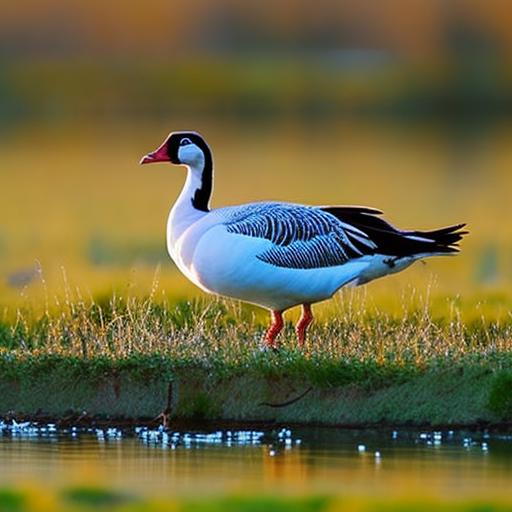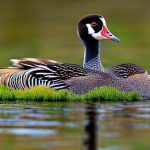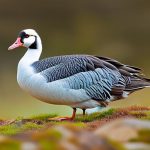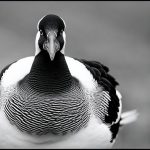The breeding season for domestic geese typically begins in late winter or early spring, when the days start to lengthen and the weather begins to warm up. During this time, geese become more active and begin to exhibit mating behaviors. It is important for breeders to understand the natural breeding cycle of geese in order to maximize breeding success. Geese are monogamous birds, and they form strong pair bonds with their mates. During the breeding season, these pairs will engage in courtship displays, such as head bobbing, honking, and wing flapping, to reinforce their bond and prepare for mating. Once the pair has bonded, the female will begin to lay eggs, typically one egg every one to two days, until she has a full clutch. The male will then fertilize the eggs, and the female will begin the incubation process. Understanding the natural breeding behaviors of geese is crucial for breeders to provide the best possible environment for successful breeding.
In addition to understanding the natural breeding behaviors of geese, breeders must also be aware of the specific breeding season for the breed of geese they are working with. Different breeds of geese may have slightly different breeding seasons, and it is important to be familiar with the specific needs and behaviors of the breed in question. For example, some breeds of geese may start their breeding season earlier or later than others, and may have different egg-laying and incubation patterns. By understanding the specific breeding season for their geese, breeders can ensure that they are providing the best possible care and environment for successful breeding.
Selecting the Right Breeding Stock for Maximum Success
Selecting the right breeding stock is crucial for maximizing breeding success in domestic geese. When choosing breeding stock, breeders should look for birds that are healthy, strong, and exhibit desirable traits for the breed. It is important to select birds that are of good size and conformation, with strong legs and feet, and a healthy, glossy plumage. In addition, breeders should look for birds that have a good temperament and are well-suited to the breeding environment. Birds that are aggressive or overly skittish may not be ideal for breeding, as they may have difficulty forming and maintaining pair bonds, or may be more prone to stress during the breeding season. Breeders should also consider the genetic background of their breeding stock, and select birds that come from healthy, productive lines with a good track record of successful breeding. By carefully selecting the right breeding stock, breeders can set themselves up for maximum success in the breeding season.
In addition to physical and genetic traits, breeders should also consider the age of their breeding stock when selecting birds for breeding. Generally, geese reach sexual maturity at around two years of age, and are most fertile and productive during their prime breeding years, which can vary depending on the breed. It is important to select breeding stock that is in the prime of their reproductive years, as older birds may have decreased fertility and egg production. However, it is also important to avoid breeding birds that are too young, as they may not be fully developed or mature enough to handle the rigors of the breeding season. By carefully selecting breeding stock that is in the prime of their reproductive years, breeders can maximize their chances of successful breeding and produce strong, healthy offspring.
Creating the Ideal Breeding Environment for Domestic Geese
Creating the ideal breeding environment is essential for successful breeding of domestic geese. Geese are naturally outdoor birds, and they thrive in a spacious, natural environment with access to fresh air, sunlight, and water. When preparing for the breeding season, breeders should ensure that their geese have access to a clean, well-ventilated shelter that provides protection from the elements and predators, as well as ample space for nesting and mating. The shelter should be bedded with clean, dry straw or shavings, and should be kept clean and free of debris to minimize the risk of disease and infection. In addition to a shelter, geese should have access to a large, secure outdoor area where they can forage, graze, and engage in natural behaviors. This outdoor area should be fenced to prevent escape and protect the geese from predators, and should include access to fresh water for drinking and bathing. By providing a spacious, natural environment for their geese, breeders can create the ideal breeding environment and set the stage for successful breeding.
In addition to providing a suitable physical environment, breeders should also consider the social dynamics of their geese when creating the breeding environment. Geese are social birds, and they form strong pair bonds with their mates. When preparing for the breeding season, breeders should ensure that their geese are housed in compatible pairs, and that they have the opportunity to form and maintain strong pair bonds. This may involve separating incompatible birds, or introducing new mates to birds that have lost their previous partner. By creating a harmonious social environment for their geese, breeders can help to reduce stress and conflict, and promote successful breeding and egg production.
Nutritional Needs and Feeding Strategies for Breeding Geese
Meeting the nutritional needs of breeding geese is essential for successful breeding and healthy offspring. During the breeding season, geese have increased energy and nutrient requirements to support egg production, incubation, and rearing of offspring. It is important for breeders to provide a balanced, high-quality diet that meets these increased nutritional needs. A good breeding diet for geese should include a mix of high-quality grains, such as corn, wheat, and barley, as well as protein-rich feeds, such as soybean meal or fish meal. In addition, geese should have access to fresh, green forage, such as grass, clover, and other leafy greens, which provide essential vitamins and minerals, as well as fiber to support digestive health. Breeders should also provide access to clean, fresh water at all times, as dehydration can have a negative impact on egg production and fertility. By providing a balanced, nutritious diet, breeders can ensure that their geese have the energy and nutrients they need for successful breeding and healthy offspring.
In addition to providing a balanced diet, breeders should also consider the feeding strategies for their breeding geese. During the breeding season, geese may have different feeding behaviors and requirements than they do at other times of the year. For example, breeding geese may have increased appetites and may require more frequent feedings to meet their increased energy needs. Breeders should monitor their geese closely and adjust their feeding strategies as needed to ensure that their birds are getting the nutrition they need. In addition, breeders should be mindful of the potential for competition and aggression at feeding time, and should provide ample feeding space and multiple feeding stations to minimize conflict and ensure that all birds have access to food. By implementing appropriate feeding strategies, breeders can help to support successful breeding and ensure that their geese are getting the nutrition they need for optimal health and productivity.
Managing Health and Wellness During the Breeding Season
Managing the health and wellness of breeding geese is essential for successful breeding and the production of healthy offspring. During the breeding season, geese may be more susceptible to stress, disease, and other health issues, and it is important for breeders to be proactive in managing the health and wellness of their birds. One of the most important aspects of managing the health of breeding geese is to provide a clean, sanitary environment that minimizes the risk of disease and infection. This includes keeping the shelter and outdoor area clean and free of debris, providing clean, fresh water at all times, and practicing good biosecurity measures to prevent the introduction and spread of disease. In addition, breeders should monitor their geese closely for signs of illness or injury, and should seek veterinary care as needed to address any health issues that arise. By maintaining a clean, healthy environment and monitoring the health of their geese, breeders can help to minimize the risk of disease and promote successful breeding and healthy offspring.
In addition to providing a clean, healthy environment, breeders should also be proactive in managing the wellness of their breeding geese. This includes providing regular opportunities for exercise and natural behaviors, such as foraging, grazing, and swimming, to promote physical and mental well-being. Breeders should also be mindful of the potential for stress during the breeding season, and should take steps to minimize stress and promote a calm, harmonious environment for their geese. This may involve providing ample space and resources, minimizing disruptions and changes to the environment, and ensuring that the social dynamics of the flock are stable and harmonious. By managing the health and wellness of their breeding geese, breeders can help to support successful breeding and the production of strong, healthy offspring.
Maximizing Fertility and Egg Production in Breeding Geese
Maximizing fertility and egg production is a key goal for breeders during the breeding season. There are several strategies that breeders can use to help maximize fertility and egg production in their geese. One important factor in maximizing fertility and egg production is to ensure that the breeding stock is in good condition and has access to a balanced, nutritious diet. Birds that are in good physical condition and have access to the nutrients they need are more likely to be fertile and productive. In addition, breeders should provide a suitable breeding environment that promotes natural mating behaviors and minimizes stress, as stress can have a negative impact on fertility and egg production. By providing a healthy, harmonious environment and a balanced diet, breeders can help to maximize fertility and egg production in their geese.
Another important strategy for maximizing fertility and egg production is to monitor the breeding stock closely and keep detailed records of egg production and fertility rates. By keeping track of the number of eggs laid, the fertility of the eggs, and the hatch rates, breeders can identify trends and patterns and make adjustments as needed to improve breeding success. For example, if a particular pair of geese is consistently producing infertile eggs, breeders may need to reevaluate the compatibility of the pair, or consider other factors that may be affecting fertility. By monitoring the breeding stock and keeping detailed records, breeders can identify potential issues and make informed decisions to maximize fertility and egg production.
Incubation and Hatching: Best Practices for Successful Brooding
Incubation and hatching are critical stages in the breeding process, and there are several best practices that breeders can use to ensure successful brooding of goose eggs. One important factor in successful incubation and hatching is to provide a suitable incubation environment that meets the specific needs of goose eggs. Goose eggs require a consistent temperature and humidity level for successful incubation, and breeders should use a reliable, accurate incubator to provide these conditions. The temperature in the incubator should be kept at around 99.5 degrees Fahrenheit, and the humidity level should be maintained at around 55-60% for the first 25 days of incubation, and then increased to around 70% for the final three days before hatching. By providing a suitable incubation environment, breeders can help to ensure that the eggs develop properly and hatch successfully.
In addition to providing a suitable incubation environment, breeders should also be proactive in monitoring the progress of the eggs and addressing any issues that arise. This may involve regularly checking the temperature and humidity levels in the incubator, as well as monitoring the development of the embryos through the use of candling. Candling involves shining a bright light through the egg to observe the development of the embryo, and can help breeders to identify any potential issues, such as infertility or developmental abnormalities. By monitoring the progress of the eggs and addressing any issues that arise, breeders can help to maximize the chances of successful hatching and the production of healthy goslings.
Caring for Goslings: Tips for Raising Healthy and Strong Offspring
Caring for goslings is an important aspect of the breeding process, and there are several tips that breeders can use to raise healthy and strong offspring. One important factor in caring for goslings is to provide a suitable brooding environment that meets the specific needs of young geese. Goslings require a warm, dry, draft-free environment with access to clean, fresh water and a balanced, nutritious diet. Breeders should use a brooder or heat lamp to provide a consistent temperature of around 90-95 degrees Fahrenheit for the first week of life, and then gradually decrease the temperature by around five degrees per week until the goslings are fully feathered. In addition, breeders should provide access to a balanced starter feed that meets the nutritional needs of young geese, as well as access to clean, fresh water at all times. By providing a suitable brooding environment and a balanced diet, breeders can help to ensure that their goslings are healthy and strong.
In addition to providing a suitable brooding environment and diet, breeders should also be proactive in monitoring the health and wellness of their goslings and addressing any issues that arise. This may involve regularly checking the goslings for signs of illness or injury, and seeking veterinary care as needed to address any health issues. Breeders should also be mindful of the potential for stress and aggression in young goslings, and should provide ample space and resources to minimize conflict and promote a calm, harmonious environment. By caring for their goslings and addressing any issues that arise, breeders can help to raise healthy, strong offspring that are well-prepared for life on the farm.
Addressing Common Challenges and Issues During the Breeding Season
During the breeding season, breeders may encounter a variety of common challenges and issues that can affect breeding success. One common challenge that breeders may face is infertility or poor hatch rates. There are several potential factors that can contribute to infertility or poor hatch rates, including age and condition of the breeding stock, environmental factors, and genetic issues. Breeders should monitor their breeding stock closely and keep detailed records of egg production and fertility rates, and should make adjustments as needed to address any issues that arise. For example, if a particular pair of geese is consistently producing infertile eggs, breeders may need to reevaluate the compatibility of the pair, or consider other factors that may be affecting fertility. By addressing common challenges and issues, breeders can help to maximize breeding success and the production of healthy offspring.
Another common challenge that breeders may encounter during the breeding season is aggression and conflict among the breeding stock. Geese can be territorial and aggressive, especially during the breeding season, and conflicts between birds can have a negative impact on the overall breeding success. Aggressive behavior can lead to injuries, stress, and decreased egg production. It is important for breeders to carefully monitor their geese during this time and be prepared to separate birds if necessary. Providing ample space, nesting areas, and resources can help reduce aggression and territorial behavior. Additionally, introducing new birds to the flock should be done gradually to minimize conflict. By managing aggression and conflict among the breeding stock, breeders can help ensure a successful and productive breeding season.
Meet Walter, the feathered-friend fanatic of Florida! Nestled in the sunshine state, Walter struts through life with his feathered companions, clucking his way to happiness. With a coop that’s fancier than a five-star hotel, he’s the Don Juan of the chicken world. When he’s not teaching his hens to do the cha-cha, you’ll find him in a heated debate with his prized rooster, Sir Clucks-a-Lot. Walter’s poultry passion is no yolk; he’s the sunny-side-up guy you never knew you needed in your flock of friends!







